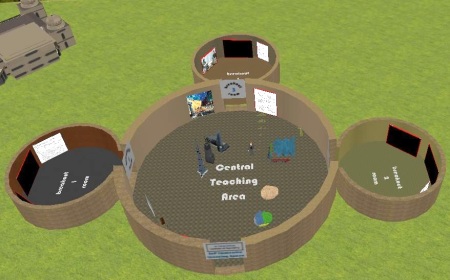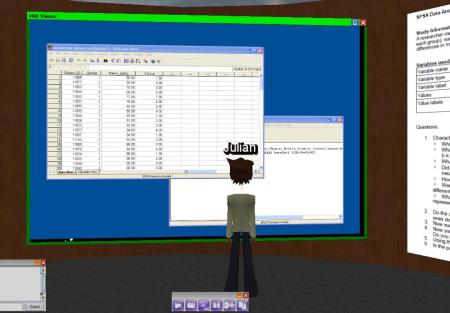This guest post is a summary version of a longer report.
Student Pilot Trial of learning statistics using SPSS embedded within Open Wonderland at King’s College London Institute of Psychiatry
 Dr. Jenny Yiend, Mental Heath Studies Progamme Director. Dr. Yiend graduated from Cambridge University where she went on to gain a PhD in anxiety and attentional processing. She held a full time research post at the MRC Cognition and Brain Sciences Unit, Cambridge, where she carried out further work on cognition in emotional disorders. At the University of Oxford she was Senior Research Fellow in the Department of Psychiatry, Honorary Lecturer in the Department of Experimental Psychology and Director of Studies for Psychology at St Hilda’s College. Dr. Yiend joined the King’s College London Institute of Psychiatry in 2009 where she continues working on cognition and emotion in psychological disorders. Her email address is jenny.yiend@kcl.ac.uk
Dr. Jenny Yiend, Mental Heath Studies Progamme Director. Dr. Yiend graduated from Cambridge University where she went on to gain a PhD in anxiety and attentional processing. She held a full time research post at the MRC Cognition and Brain Sciences Unit, Cambridge, where she carried out further work on cognition in emotional disorders. At the University of Oxford she was Senior Research Fellow in the Department of Psychiatry, Honorary Lecturer in the Department of Experimental Psychology and Director of Studies for Psychology at St Hilda’s College. Dr. Yiend joined the King’s College London Institute of Psychiatry in 2009 where she continues working on cognition and emotion in psychological disorders. Her email address is jenny.yiend@kcl.ac.uk
 Julian Fletcher, Ed. Development Manager & MHSP Team[1]. Julian Fletcher has Master degrees in Electronic Engineering from the University of Nottingham and in Education,Technology and Society from the University of Bristol and is a Chartered Engineer and Prince 2 Project Management Practitioner. He spent the first 10 years of his career working as a software engineer and web designer in several UK private sector organisations and following that and further study he worked as the e-Leaning Manager for the University for the Creative Arts and since 2008 the King’s College London Institute of Psychiatry where he works currently. Julian was first shown Project Wonderland in late 2008 and has been working with it ever since. His email address is julian.fletcher@kcl.ac.uk
Julian Fletcher, Ed. Development Manager & MHSP Team[1]. Julian Fletcher has Master degrees in Electronic Engineering from the University of Nottingham and in Education,Technology and Society from the University of Bristol and is a Chartered Engineer and Prince 2 Project Management Practitioner. He spent the first 10 years of his career working as a software engineer and web designer in several UK private sector organisations and following that and further study he worked as the e-Leaning Manager for the University for the Creative Arts and since 2008 the King’s College London Institute of Psychiatry where he works currently. Julian was first shown Project Wonderland in late 2008 and has been working with it ever since. His email address is julian.fletcher@kcl.ac.uk
Overview
The Institute of Psychiatry (IoP) Mental Health Studies Programme (MHSP) is the first in King’s College London to trial the use of a distributed application, embedded within a virtual 3D environment, for teaching and learning purposes. The pilot trial was conducted on 15th August 2011 in an Open Wonderland (OWL) virtual environment. The content was designed by the IoP Education Development Manager (Fletcher) and hosted on the IoP’s Denmark Hill Campus LAN. The tutor and three students presented themselves as avatars and used the embedded SPSS statistics application together with the environment’s built-in audio facilities to interactively collaborate and complete a structured statistical teaching and learning exercise.
Feasibility Pilot
Currently the IoP Mental Health Studies Programme teaches research methods to its 110 students via 90 minute lectures or practical workshops held once a week. There is some divergence between the theory that students learn in the classroom setting and the case examples they practise upon and their ability to apply this knowledge to the real data that they gather as part of their research projects. Since 2009, MHSP has contemplated the use of the OWL 3D virtual environment to target this need specifically by providing a new fortnightly problem-based learning session in which students participate interactively and collaboratively.
The trial consisted of an introduction to the task by the tutor, a structured SPSS tasking lasting about 40 minutes during which the tutor and 3 students carried out simple SPSS exercises, followed by a more open-ended period of exploration of the world by the students.
Each of the three Breakout Rooms consisted of a VNC Viewer screen for displaying a distributed application, a screen for displaying a video and either a poster in the case of Breakout Room 1 or a PDF Viewer in the cases of Breakout Rooms 2 & 3 for displaying documents. In the Breakout Room 1, used in this trial, the SPSS statistics application was displayed in the VNC Viewer (Fig 2) which the tutor and students could interact with through their clients (Fig 3). There was also a video player screen which displayed a video produced by the University of Minnesota Department of Sociology on how to use SPSS. An in-world poster was used to display the instructions for the statistical tasks to be carried out in the trial.
The OWL firewall ports between the Education Development Manager‘s workstation and the three client workstations were opened for the duration of the trial to enable communication of sound and visual data. Notwithstanding the occasional logout of one or more client browsers, the server performance was fairly robust with good sound clarity for both speaking and listening. Both the tutor and the 3 students used headsets with built-in microphones procured from Argos for £7.99 each. These inexpensive headsets did the job satisfactorily. This £31.96 was the only fixed expense incurred by the trial other than the beverages bought for the participating students by way of a small thank you for their contribution to it. This short video clip shows the pilot setup:
The degree of prior familiarity with game technologies seems to dictate how quickly students can familiarise themselves with and navigate around the OWL environment. One student had such existing experience being an enthusiastic games player whereas the other two had to rely on more explicit tutorial guidance to get started. All three students, however, succeeded in becoming familiar and comfortable using OWL and none dismissed it out of hand as something they simply could not use.
All three students have willingly adopted the collaborative style of learning that applications embedded into OWL are designed to foster. Their responses indicate that there is an optimum size group of students around a single application to make such collaboration work (no greater than 4 when one includes the tutor). The need to take control of the application in turns in order to interact with it, while making that interaction slow at times, has the benefit of ensuring all students can keep up with the task and have a chance to practically apply their knowledge through completing the task.
All three students shared the opinion that working in groups collaboratively and learning more about statistics through communicating with each other was what they liked best about the exercise. The ability to talk to teach other using OWL’s audio facility and the need to take it in turns to complete the task encouraged such collaboration.
Overall the pilot feedback suggested:
- An optimum group size for this application is about 4 students working together.
- Retaining concentration could be improved by enhancing visual and interactive content of the environment. This highlights the need to have architectural designers with proficient 3D design skills to build such content and programmers with proficient scripting skills to make it interactive.
- More sophisticated, ‘human like’ and individually distinct avatars to make online conversations more natural. The College-issued PCs did not support the 3D graphics necessary to render OWL’s customizable avatars.
- Delays of respective clients to render the world can significantly impair its use. This needs to be ameliorated by using a more dedicated and higher performance specification OWL client/server hosting solution.
- Using a virtual environment such as OWL can help students to further engage with and be more motivated to learn and apply statistics, supplementing and consolidating what they learn in their current classroom sessions by making such learning a more ‘hands-on’ activity.
Even taking account of the limitations of this pilot exercise – e.g. a small group of participating students, and computer and network hardware not designed for anything as memory intensive as immersive virtual worlds – this pilot trial can be judged at the very least a qualified success. For the most part, the technology worked for the duration of the trial (far better than the Education Development Manager dared hope!) and none of the students dismissed using virtual worlds as part of their teaching and learning as a completely bad idea! In fact they were on balance positive about its potential.
Scope for further work
Taking the current pilot to the next stage will require a more powerful Open Wonderland hosted service as well as more appropriate client hardware. This is currently being investigated at the College level.
Some further thought on the design of both SPSS tasks themselves from a pedagogical perspective and the content within the OWL environment will also need to take place. In particular, the personalisation of avatars will take on increased importance when more students will be in-world concurrently than was the case with this small trial.
Finally, it should not be the goal of virtual worlds to replace what the MHSP currently does perfectly well using more ‘traditional’ methods such as class-based lectures and training courses. Rather, the purpose is to augment such activities through giving students increased scope to apply the statistical theory they are taught in class and in textbooks to practical data sets related to their own course of research.
It was especially pleasing to note how students were happy to help each other and learn from each other in the collaborative in-world SPSS task. This is likely to help to inculcate wider transferable skills such as team working and proactive problem solving.
[1] Sophie Ciaramella, Kalbir Sohi, Matthew Isard, Emily Leathers-Smith and Helen Aivazian






 Posted by Nicole Yankelovich
Posted by Nicole Yankelovich